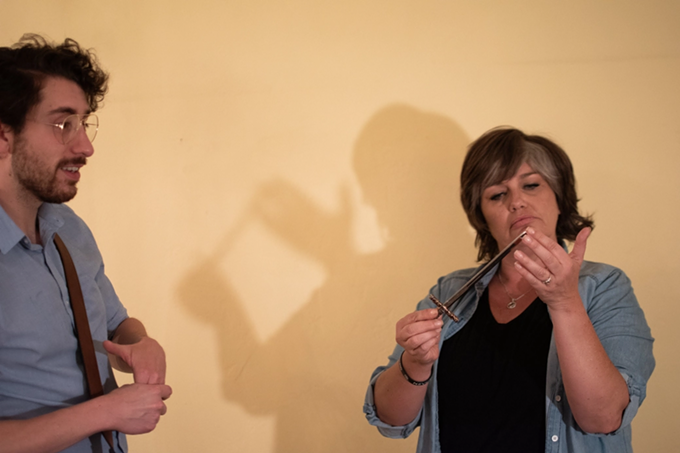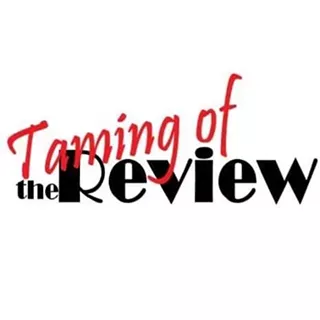Switzerland, by Joanna Murray-Smith, is a dark comedy with razor sharp commentary on literature, creativity and society—and it isn't shy about pressing that razor to the audience's throat. With this play, Something Something Theatre and director Whitney Morton Woodcock delve into the complicated life and legacy of author Patricia Highsmith, who penned psychological thrillers such as The Talented Mr. Ripley (and its four sequels) and Strangers on a Train. The play goes beyond one woman's work, though; it questions authorial power and literary impact, as well as the institutions producing, publishing and reviewing books. What's more, it questions the basic nature of the self and of humanity, challenging notions of reflection and knowledge, good and evil, and growth and change.
The play is a taut, close look at Highsmith (played by Sarah Macmillan) as she struggles to write one more Ripley novel: one final, triumphant success. Edward Ridgeway (played by Damian Garcia) arrives, sent by Highsmith's publisher with instructions to ensure that the cash cow produces to their satisfaction. Highsmith and Ridgeway engage in a battle of wits and wills, flinging venomous verbal volleys at one another as they prod each other for weaknesses to exploit. They fluctuate between conspiratorial camaraderie and threats both subtle and overt as the future of Tom Ripley hangs in the balance.
Macmillan and Garcia have a strong rapport, building ever-increasing tension as the play progresses. The play ruminates on reading and writing, repeatedly casting the author as a god whose words create worlds and people. The audience is presented with the long-vaunted notion of authorial immortality through their works, but simultaneously reminded of the misogyny of the American literary fraternity. Writing is the primary focus, as Highsmith struggles to match her earlier successes, but the banter also questions the connections forged through books, emphasizing the inherent human engagement in sharing stories, even as the audience is reminded that, while a reader might feel an overwhelming connection to an author or character, that connection runs only in one direction.
As the play dissects the act of creative production, from an author's idea all the way through a publisher's printing, it also investigates the makeup of people and their society. Highsmith is a cynical, racist, bigot who eagerly looks for the worst in people, dreaming up death and violence and taking delight in guns, knives and poison. At one point, she asserts, "If you put two people in a room together and their true selves emerge, only one of them is going to make it." Ridgeway calls out Highsmith on her ugliness and meanness, briefly championing social progress and change, even as he himself moves along the spectrum of (a)morality. The characters' slipperiness is challenging, as the audience is forced to ponder whether we like or loathe these people, as we find ourselves alternately laughing and cringing at their banter. We're also forced to reckon with the question of whether we have, in fact, moved beyond the ignorance derided by Ridgeway, as well as the thorny issue of how we, as contemporary consumers, interact with literature or art produced by people with problematic or even abhorrent views.
Macmillan and Garcia are strong actors and play off each other well, pairing the often-rapid conversation with intense physical presence; it's remarkable how much they convey in their postures and invasions of each other's space. Their shifting dynamic is utterly engaging, and the simmering pressure keeps the audience wondering not only if and when the knife will slash out, but whose blood will be drawn when it does.
The set, designed by Marchus Lewis, is a shrine to literature and death. Books and weapons line the shelves, while swords, masks, and skulls adorn the walls. Every item speaks to the action and themes of the play and feels provocatively deliberate. So too are the costumes, particularly Garcia's, which speak volumes over the progress of the action. The actors designed the costuming themselves, with minimal input from the director.
The tightly paced plot unfolds like one of Highsmith's own thrillers, with clues and red herrings leading up to the climactic finale. In the final moments of the play, an audience member nearby breathed out a heartfelt "What the f*ck" as the scene closed out.
Whether you see the twists coming or not, going to Switzerland is one darkly fun trip you'll want to take.









